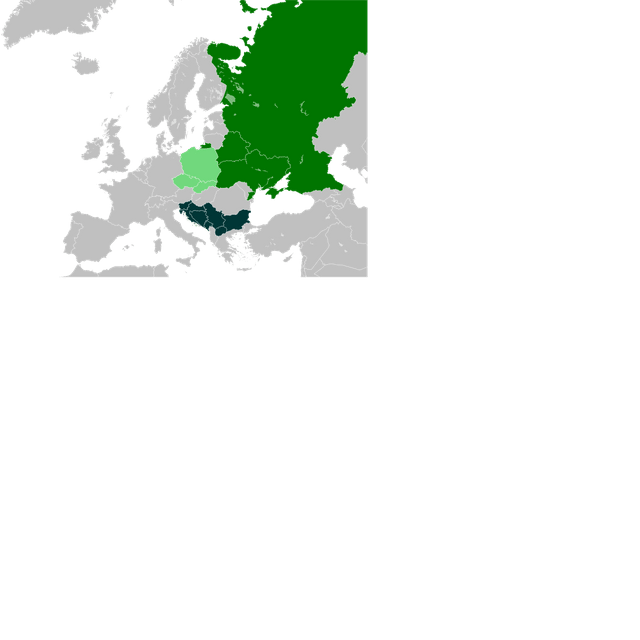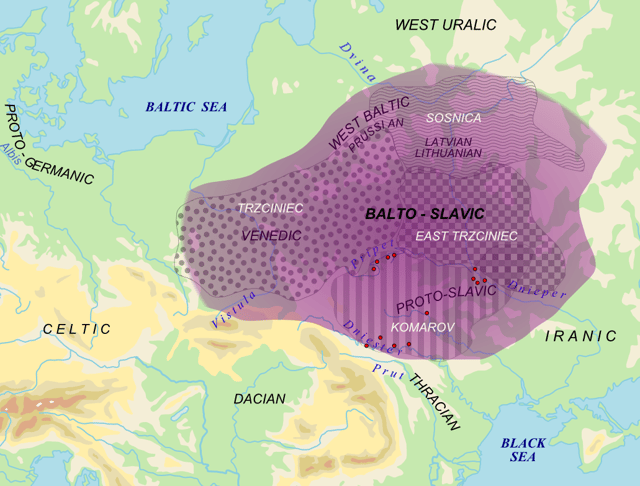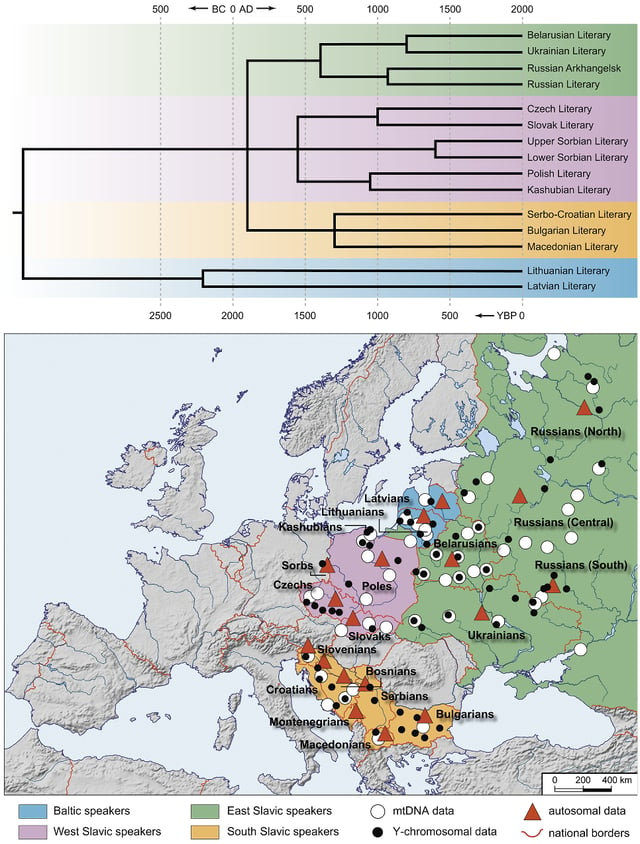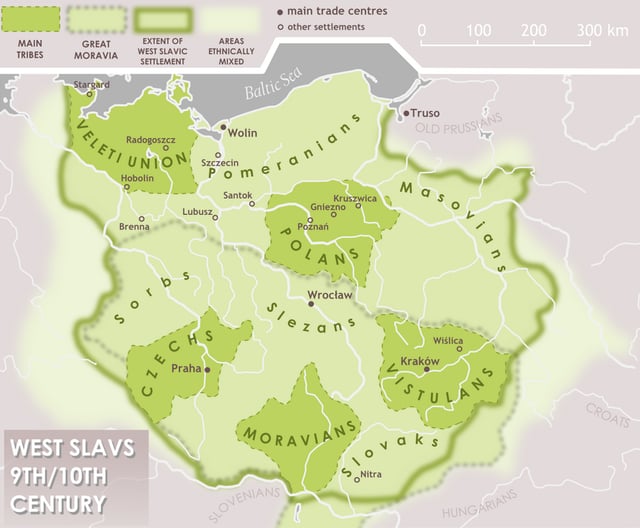Slavic languages

Slavic languages

| Slavic | |
|---|---|
| Slavonic | |
| Ethnicity | Slavs |
| Geographic distribution | Throughout Central and Eastern Europe, Central Asia, and Russia |
| Linguistic classification | Indo-European
|
| Proto-language | Proto-Slavic |
| Subdivisions |
|
| ISO 639-2 / 5 | sla |
| Linguasphere | 53= (phylozone) |
| Glottolog | slav1255 [38][1] |
The Slavic languages (also called Slavonic languages) are the Indo-European languages spoken by the Slavic peoples. They are thought to descend from a proto-language called Proto-Slavic, spoken during the Early Middle Ages, which in turn is thought to have descended from the earlier Proto-Balto-Slavic language, linking the Slavic languages to the Baltic languages in a Balto-Slavic group within the Indo-European family.
The Slavic languages are conventionally (that is, also on the basis of extralinguistic features) divided intro three subgroups: East, West, and South, which together constitute more than 20 languages. Of these, 10 have at least one million speakers and official status as the national languages of the countries in which they are predominantly spoken: Russian, Belarusian and Ukrainian (of the East group), Polish, Czech and Slovak (of the West group) and Bulgarian and Macedonian (eastern dialects of the South group), and Serbo-Croatian and Slovene (western dialects of the South group).
The current geographic distribution of natively spoken Slavic languages covers Eastern Europe, the Balkans, Central Europe and all of the territory of Russia, which includes northern and north-central Asia. Furthermore, the diasporas of many Slavic peoples have established isolated minorities of speakers of their languages all over the world. The number of speakers of all Slavic languages together is estimated to be 315 million.[2][3] Despite the large extent, the individual Slavic languages are considerably less differentiated than Germanic and Romance languages.
| Slavic | |
|---|---|
| Slavonic | |
| Ethnicity | Slavs |
| Geographic distribution | Throughout Central and Eastern Europe, Central Asia, and Russia |
| Linguistic classification | Indo-European
|
| Proto-language | Proto-Slavic |
| Subdivisions |
|
| ISO 639-2 / 5 | sla |
| Linguasphere | 53= (phylozone) |
| Glottolog | slav1255 [38][1] |
Branches

Balto-Slavic language tree.
Since the interwar period scholars have traditionally divided Slavic languages, on the basis of geographical and genealogical principle, and with the use of the extralinguistic feature of script, into three main branches, that is, East, West and South. (From the vantage of linguistic features alone, there are only two branches of the Slavic languages, namely North and South.[4][5] These three conventional branches feature some of the following subbranches:
Some linguists speculate that a North Slavic branch has existed as well. The Old Novgorod dialect may have reflected some idiosyncrasies of this group. Mutual intelligibility also plays a role in determining the West, East, and South branches. Speakers of languages within the same branch will in most cases be able to understand each other at least partially, but they are generally unable to across branches (which would be comparable to a native English speaker trying to understand any other Germanic language).
The most obvious differences between the East, West and South Slavic branches are in the orthography of the standard languages: West Slavic languages (and Western South Slavic languages - Croatian and Slovene) are written in the Latin script, and have had more Western European influence due to their proximity and speakers being historically Roman Catholic, whereas the East Slavic and Eastern South Slavic languages are written in Cyrillic and, with Eastern Orthodox or Uniate faith, have had more Greek influence. East Slavic languages such as Russian have, however, during and after Peter the Great's Europeanization campaign, absorbed many words of Latin, French, German, and Italian origin.
The tripartite division of the Slavic languages does not take into account the spoken dialects of each language. Of these, certain so-called transitional dialects and hybrid dialects often bridge the gaps between different languages, showing similarities that do not stand out when comparing Slavic literary (i.e. standard) languages. For example, Slovak (West Slavic) and Ukrainian (East Slavic) are bridged by the Rusyn language/dialect of Eastern Slovakia and Western Ukraine.[6] Similarly, the Croatian Kajkavian dialect is more similar to Slovene than to the standard Croatian language.
Although the Slavic languages diverged from a common proto-language later than any other group of the Indo-European language family, enough differences exist between the various Slavic dialects and languages to make communication between speakers of different Slavic languages difficult. Within the individual Slavic languages, dialects may vary to a lesser degree, as those of Russian, or to a much greater degree, as those of Slovene.
History
Common roots and ancestry

Area of Balto-Slavic dialectic continuum (purple) with proposed material cultures correlating to speakers Balto-Slavic in Bronze Age (white). Red dots = archaic Slavic hydronyms

Baška tablet, 11th century, Krk, Croatia.
Slavic languages descend from Proto-Slavic, their immediate parent language, ultimately deriving from Proto-Indo-European, the ancestor language of all Indo-European languages, via a Proto-Balto-Slavic stage. During the Proto-Balto-Slavic period a number of exclusive isoglosses in phonology, morphology, lexis, and syntax developed, which makes Slavic and Baltic the closest related of all the Indo-European branches. The secession of the Balto-Slavic dialect ancestral to Proto-Slavic is estimated on archaeological and glottochronological criteria to have occurred sometime in the period 1500–1000 BCE.[7]
A minority of Baltists maintain the view that the Slavic group of languages differs so radically from the neighboring Baltic group (Lithuanian, Latvian, and the now-extinct Old Prussian), that they could not have shared a parent language after the breakup of the Proto-Indo-European continuum about five millennia ago. Substantial advances in Balto-Slavic accentology that occurred in the last three decades, however, make this view very hard to maintain nowadays, especially when one considers that there was most likely no "Proto-Baltic" language and that West Baltic and East Baltic differ from each other as much as each of them does from Proto-Slavic.[8]
Evolution

14th-century Novgorodian children were literate enough to send each other letters written on birch bark.

10th–11th century Codex Zographensis, canonical monument of Old Church Slavonic/Old Bulgarian.
The imposition of Old Church Slavonic on Orthodox Slavs was often at the expense of the vernacular. Says WB Lockwood, a prominent Indo-European linguist, "It (O.C.S) remained in use to modern times but was more and more influenced by the living, evolving languages, so that one distinguishes Bulgarian, Serbian, and Russian varieties. The use of such media hampered the development of the local languages for literary purposes, and when they do appear the first attempts are usually in an artificially mixed style." (148)
Lockwood also notes that these languages have "enriched" themselves by drawing on Church Slavonic for the vocabulary of abstract concepts. The situation in the Catholic countries, where Latin was more important, was different. The Polish Renaissance poet Jan Kochanowski and the Croatian Baroque writers of the 16th century all wrote in their respective vernaculars (though Polish itself had drawn amply on Latin in the same way Russian would eventually draw on Church Slavonic).
Although Church Slavonic hampered vernacular literatures, it fostered Slavonic literary activity and abetted linguistic independence from external influences. Only the Croatian vernacular literary tradition nearly matches Church Slavonic in age. It began with the Vinodol Codex and continued through the Renaissance until the codifications of Croatian in 1830, though much of the literature between 1300 and 1500 was written in much the same mixture of the vernacular and Church Slavonic as prevailed in Russia and elsewhere.
The most important early monument of Croatian literacy is the Baška tablet from the late 11th century. It is a large stone tablet found in the small Church of St. Lucy, Jurandvor on the Croatian island of Krk, containing text written mostly in Čakavian dialect in angular Croatian Glagolitic script. The independence of Dubrovnik facilitated the continuity of the tradition.
More recent foreign influences follow the same general pattern in Slavic languages as elsewhere and are governed by the political relationships of the Slavs. In the 17th century, bourgeois Russian (delovoi jazyk) absorbed German words through direct contacts between Russians and communities of German settlers in Russia. In the era of Peter the Great, close contacts with France invited countless loan words and calques from French, a significant fraction of which not only survived but also replaced older Slavonic loans. In the 19th century, Russian influenced most literary Slavic languages by one means or another.
Differentiation

Map and tree of Slavic languages, according to Kassian and A. Dybo
The Proto-Slavic language existed until around AD 500. By the 7th century, it had broken apart into large dialectal zones.
There are no reliable hypotheses about the nature of the subsequent breakups of West and South Slavic. East Slavic is generally thought to converge to one Old Russian or Old East Slavonic language, which existed until at least the 12th century.
Linguistic differentiation was accelerated by the dispersion of the Slavic peoples over a large territory, which in Central Europe exceeded the current extent of Slavic-speaking majorities. Written documents of the 9th, 10th, and 11th centuries already display some local linguistic features. For example, the Freising manuscripts show a language that contains some phonetic and lexical elements peculiar to Slovene dialects (e.g. rhotacism, the word krilatec). The Freising manuscripts are the first Latin-script continuous text in a Slavic language.
The migration of Slavic speakers into the Balkans in the declining centuries of the Byzantine Empire expanded the area of Slavic speech, but the pre-existing writing (notably Greek) survived in this area. The arrival of the Hungarians in Pannonia in the 9th century interposed non-Slavic speakers between South and West Slavs. Frankish conquests completed the geographical separation between these two groups, also severing the connection between Slavs in Moravia and Lower Austria (Moravians) and those in present-day Styria, Carinthia, East Tyrol in Austria, and in the provinces of modern Slovenia, where the ancestors of the Slovenes settled during first colonisation.
In September 2015, Alexei Kassian and Anna Dybo published,[9] as a part of interdisciplinary study of Slavic ethnogenesis, a lexicostatistical classification of Slavic languages. It was built using qualitative 110-word Swadesh lists that were compiled according to the standards of the Global Lexicostatistical Database project[10] and processed using modern phylogenetic algorithms.
The resulting dated tree complies with the traditional expert views on the Slavic group structure. Kassian-Dybo’s tree suggests that Proto-Slavic first diverged into three branches: Eastern, Western and Southern. The Proto-Slavic break-up is dated to around 100 A.D., which correlates with the archaeological assessment of Slavic population in the early 1st millennium A.D. being spread on a large territory[11] and already not being monolithic.[12] Then, in the 5th and 6th centuries A.D., these three Slavic branches almost simultaneously divided into sub-branches, which corresponds to the fast spread of the Slavs through Eastern Europe and the Balkans during the second half of the 1st millennium A.D. (the so-called Slavicization of Europe).[13][14][15][16]
The Slovenian language was excluded from the analysis, as both Ljubljana koine and Literary Slovenian show mixed lexical features of Southern and Western Slavic languages (which could possibly indicate the Western Slavic origin of Slovenian, which for a long time was being influenced on the part of the neighboring Serbo-Croatian dialects), and the quality Swadesh lists were not yet collected for Slovenian dialects. Because of scarcity or unreliability of data, the study also did not cover the so-called Old Novgordian dialect, the Polabian language and some other Slavic lects.
Linguistic history
The following is a summary of the main changes from Proto-Indo-European (PIE) leading up to the Common Slavic (CS) period immediately following the Proto-Slavic language (PS).
Satemisation: PIE *ḱ, *ǵ, *ǵʰ → *ś, *ź, *źʰ (→ CS *s, *z, *z) PIE *kʷ, *gʷ, *gʷʰ → *k, *g, *gʰ
Ruki rule: Following *r, *u, *k or *i, PIE *s → *š (→ CS *x)
Loss of voiced aspirates: PIE *bʰ, *dʰ, *gʰ → *b, *d, *g
Merger of *o and *a: PIE *a/*o, *ā/*ō → PS *a, *ā (→ CS *o, *a)
Law of open syllables: All closed syllables (syllables ending in a consonant) are eventually eliminated, in the following stages: Nasalization: With *N indicating either *n or *m not immediately followed by a vowel: PIE *aN, *eN, *iN, *oN, *uN → *ą, *ę, *į, *ǫ, *ų (→ CS *ǫ, *ę, *ę, *ǫ, *y). (NOTE: *ą *ę etc. indicates a nasalized vowel.) In a cluster of obstruent (stop or fricative) + another consonant, the obstruent is deleted unless the cluster can occur word-initially. (occurs later, see below) Monophthongization of diphthongs. (occurs much later, see below) Elimination of liquid diphthongs (e.g. *er, *ol when not followed immediately by a vowel).
First palatalization: *k, *g, *x → CS *č, *ž, *š (pronounced [tʃ], [ʒ], [ʃ] respectively) before a front vocalic sound (*e, *ē, *i, *ī, *j).
Iotation: Consonants are palatalized by an immediately following *j: *sj, *zj → CS *š, *ž *nj, *lj, *rj → CS *ň, *ľ, *ř (pronounced [nʲ lʲ rʲ] or similar) *tj, *dj → CS *ť, *ď (probably palatal stops, e.g. [c ɟ], but developing in different ways depending on the language) *bj, *pj, *mj, *wj → *bľ, *pľ, *mľ, *wľ (the lateral consonant *ľ is mostly lost later on in West Slavic)
Vowel fronting: After *j or some other palatal sound, back vowels are fronted (*a, *ā, *u, *ū, *ai, *au → *e, *ē, *i, *ī, *ei, *eu). This leads to hard/soft alternations in noun and adjective declensions.
Prothesis: Before a word-initial vowel, *j or *w is usually inserted.
Monophthongization: *ai, *au, *ei, *eu, *ū → *ē, *ū, *ī, *jū, *ȳ [ɨː]
Second palatalization: *k, *g, *x → CS *c [ts], *dz, *ś before new *ē (from earlier *ai). *ś later splits into *š (West Slavic), *s (East/South Slavic).
Progressive palatalization (or "third palatalization"): *k, *g, *x → CS *c, *dz, *ś after *i, *ī in certain circumstances.
Vowel quality shifts: All pairs of long/short vowels become differentiated as well by vowel quality: *a, *ā → CS *o, *a *e, *ē → CS *e, *ě (originally a low-front sound [æ] but eventually raised to [ie] in most dialects, developing in divergent ways) *i, *u → CS *ь, *ъ (also written *ĭ, *ŭ; lax vowels as in the English words pit, put) *ī, *ū, *ȳ → CS *i, *u, *y
Elimination of liquid diphthongs: Liquid diphthongs (sequences of vowel plus *l or *r, when not immediately followed by a vowel) are changed so that the syllable becomes open: *or, *ol, *er, *el → *ro, *lo, *re, *le in West Slavic. *or, *ol, *er, *el → *oro, *olo, *ere, *olo in East Slavic. *or, *ol, *er, *el → *rā, *lā, *re, *le in South Slavic. Possibly, *ur, *ul, *ir, *il → syllabic *r, *l, *ř, *ľ (then develops in divergent ways).
Development of phonemic tone and vowel length (independent of vowel quality): Complex developments (see History of accentual developments in Slavic languages).
Features
The Slavic languages are a relatively homogeneous family, compared with other families of Indo-European languages (e.g. Germanic, Romance, and Indo-Iranian). As late as the 10th century AD, the entire Slavic-speaking area still functioned as a single, dialectally differentiated language, termed Common Slavic. Compared with most other Indo-European languages, the Slavic languages are quite conservative, particularly in terms of morphology (the means of inflecting nouns and verbs to indicate grammatical differences). Most Slavic languages have a rich, fusional morphology that conserves much of the inflectional morphology of Proto-Indo-European.[17]
Consonants
The following table shows the inventory of consonants of Late Common Slavic:[18]
1The sound /sʲ/ did not occur in West Slavic, where it had developed to /ʃ/.
This inventory of sounds is quite similar to what is found in most modern Slavic languages. The extensive series of palatal consonants, along with the affricates *ts and *dz, developed through a series of palatalizations that happened during the Proto-Slavic period, from earlier sequences either of velar consonants followed by front vowels (e.g. *ke, *ki, *ge, *gi, *xe, and *xi), or of various consonants followed by *j (e.g. *tj, *dj, *sj, *zj, *rj, *lj, *kj, and *gj, where *j is the palatal approximant ([j], the sound of the English letter "y" in "yes" or "you").
The biggest change in this inventory results from a further general palatalization occurring near the end of the Common Slavic period, where all consonants became palatalized before front vowels. This produced a large number of new palatalized (or "soft") sounds, which formed pairs with the corresponding non-palatalized (or "hard") consonants[17] and absorbed the existing palatalized sounds *lʲ *rʲ *nʲ *sʲ. These sounds were best preserved in Russian but were lost to varying degrees in other languages (particularly Czech and Slovak). The following table shows the inventory of modern Russian:
This general process of palatalization did not occur in Serbo-Croatian and Slovenian. As a result, the modern consonant inventory of these languages is nearly identical to the Late Common Slavic inventory.
Late Common Slavic tolerated relatively few consonant clusters. However, as a result of the loss of certain formerly present vowels (the weak yers), the modern Slavic languages allow quite complex clusters, as in the Russian word взблеск [vzblʲesk] ("flash"). Also present in many Slavic languages are clusters rarely found cross-linguistically, as in Russian ртуть [rtutʲ] ("mercury") or Polish mchu [mxu] ("moss", gen. sg.). The word for "mercury" with the initial rt- cluster, for example, is also found in the other East and West Slavic languages, although Slovak retains an epenthetic vowel (ortuť).
Vowels
A typical vowel inventory is as follows:
| Front | Central | Back | |
|---|---|---|---|
| Close | i | (ɨ) | u |
| Mid | e | o | |
| Open | a |
The sound [ɨ] occurs only in some languages (Russian and Belarusian), and even in these languages, it is unclear whether it is its own phoneme or an allophone of /i/. Nonetheless, it is a quite prominent and noticeable characteristic of the languages in which it is present.
Russian мышь [mɨʂ] and Polish mysz [mɨʂ] "mouse"
Common Slavic also had two nasal vowels: *ę [ẽ] and *ǫ [õ]. However, these are preserved only in modern Polish (along with a few lesser-known dialects and microlanguages; see Yus for more details).
Polish wąż /vɔ̃ʐ/ and węże /vɛ̃ʐɛ/ "snake, snakes"
Other phonemic vowels are found in certain languages (e.g. the schwa /ə/ in Bulgarian and Slovenian, distinct high-mid and low-mid vowels in Slovenian, and the lax front vowel /ɪ/ in Ukrainian).
Length, accent, and tone
An area of great difference among Slavic languages is that of prosody (i.e. syllabic distinctions such as vowel length, accent, and tone). Common Slavic had a complex system of prosody, inherited with little change from Proto-Indo-European. This consisted of phonemic vowel length and a free, mobile pitch accent:
All vowels could occur either short or long, and this was phonemic (it could not automatically be predicted from other properties of the word).
There was (at most) a single accented syllable per word, distinguished by higher pitch (as in modern Japanese) rather than greater dynamic stress (as in English).
Vowels in accented syllables could be pronounced with either a rising or falling tone (i.e. there was pitch accent), and this was phonemic.
The accent was free in that it could occur on any syllable and was phonemic.
The accent was mobile in that its position could potentially vary among closely related words within a single paradigm (e.g. the accent might land on a different syllable between the nominative and genitive singular of a given word).
Even within a given inflectional class (e.g. masculine i-stem nouns), there were multiple accent patterns in which a given word could be inflected. For example, most nouns in a particular inflectional class could follow one of three possible patterns: Either there was consistent accent on the root (pattern A), predominant accent on the ending (pattern B), or accent that moved between root and ending (pattern C). In patterns B and C, the accent in different parts of the paradigm shifted not only in location but also type (rising vs. falling). Each inflectional class had its own version of patterns B and C, which might differ significantly from one inflectional class to another.
The modern languages vary greatly in the extent to which they preserve this system. On one extreme, Serbo-Croatian preserves the system nearly unchanged (even more so in the conservative Chakavian dialect); on the other, Macedonian has basically lost the system in its entirety. Between them are found numerous variations:
Slovenian preserves most of the system but has shortened all unaccented syllables and lengthened non-final accented syllables so that vowel length and accent position largely co-occur.
Russian and Bulgarian have eliminated distinctive vowel length and tone and converted the accent into a stress accent (as in English) but preserved its position. As a result, the complexity of the mobile accent and the multiple accent patterns still exists (particularly in Russian because it has preserved the Common Slavic noun inflections, while Bulgarian has lost them).
Czech and Slovak have preserved phonemic vowel length and converted the distinctive tone of accented syllables into length distinctions. Phonemic accent is otherwise lost, but the former accent patterns are echoed to some extent in corresponding patterns of vowel length/shortness in the root. Paradigms with mobile vowel length/shortness do exist but only in a limited fashion, usually only with the zero-ending forms (nom. sg., acc. sg., and/or gen. pl., depending on inflectional class) having a different length from the other forms. (Czech has a couple of other "mobile" patterns, but they are rare and can usually be substituted with one of the "normal" mobile patterns or a non-mobile pattern.)
Old Polish had a system very much like Czech. Modern Polish has lost vowel length, but some former short-long pairs have become distinguished by quality (e.g. [o oː] > [o u]), with the result that some words have vowel-quality changes that exactly mirror the mobile-length patterns in Czech and Slovak.
Grammar
Selected cognates
The following is a very brief selection of cognates in basic vocabulary across the Slavic language family, which may serve to give an idea of the sound changes involved. This is not a list of translations: cognates have a common origin, but their meaning may be shifted and loanwords may have replaced them.
| Proto-Slavic | Russian | Ukrainian | Belarusian | Polish | Czech | Slovak | Slovene | Serbo-Croatian | Bulgarian | Macedonian |
|---|---|---|---|---|---|---|---|---|---|---|
| *uxo (ear) | ухо (úkho) | вухо (vúkho) | вуха (vúkha) | ucho | ucho | ucho | uho | уво / uvo; uho | ухо (ukhó) | уво (úvo) |
| *ognь (fire) | огонь (ogónʹ) | вогонь (vohónʹ) | агонь (ahónʹ) | ogień | oheň | oheň | ogenj | огањ / oganj | огън (ógǎn) | оган/огин (ógan/ógin) |
| *ryba (fish) | рыба (rýba) | риба (rýba) | рыба (rýba) | ryba | ryba | ryba | riba | риба / riba | риба (ríba) | риба (ríba) |
| *gnězdo (nest) | гнездо (gnezdó) | гнiздо (hnizdó) | гняздо (hnyazdó) | gniazdo | hnízdo | hniezdo | gnezdo | гн(иј)ездо / gn(ij)ezdo | гнездо (gnezdó) | гнездо (gnézdo) |
| *oko (eye) | око (óko) (dated, poetic or in set expressions) modern: глаз (glaz) | око (óko) | вока (vóka) | oko | oko | oko | oko | око / oko | око (óko) | око (óko) |
| *golva (head) | голова (golová) глава (glavá) "chapter or chief, leader, head" | голова (holová) | галава (halavá) | głowa | hlava | hlava | glava | глава / glava | глава (glavá) | глава (gláva) |
| *rǫka (hand) | рука (ruká) | рука (ruká) | рука (ruká) | ręka | ruka | ruka | roka | рука / ruka | ръка (rǎká) | рака (ráka) |
| *noktь (night) | ночь (nočʹ) | ніч (nič) | ноч (noč) | noc | noc | noc | noč | ноћ / noć | нощ (nosht) | ноќ (noḱ) |
Influence on neighboring languages

West Slav tribes in 9th–10th centuries
Most languages of the former Soviet Union and of some neighbouring countries (for example, Mongolian) are significantly influenced by Russian, especially in vocabulary. The Romanian, Albanian, and Hungarian languages show the influence of the neighboring Slavic nations, especially in vocabulary pertaining to urban life, agriculture, and crafts and trade—the major cultural innovations at times of limited long-range cultural contact. In each one of these languages, Slavic lexical borrowings represent at least 15% of the total vocabulary. However, Romanian has much lower influence from Slavic than Albanian or Hungarian. This is potentially because Slavic tribes crossed and partially settled the territories inhabited by ancient Illyrians and Vlachs on their way to the Balkans.
Although also spoken in neighbouring lands, the Germanic languages show less significant Slavic influence, partly because Slavic migrations were mostly headed south rather than west. Slavic tribes did push westwards into Germanic territory, but borrowing for the most part seems to have been from Germanic to Slavic rather than the other way: for instance, the now-extinct Polabian language was heavily influenced by German, far more than any living Slavic language today. The Slavic contributions to Germanic languages remains a moot question, though Max Vasmer, a specialist in Slavic etymology, has claimed that there were no Slavic loans into Proto-Germanic. The only Germanic languages that shows significant Slavic influence are Yiddish and the historical colonial dialects of German that were spoken East of the Oder–Neisse line, such as Silesian German (formerly spoken in Silesia and South of East Prussia) and the Eastern varieties of East Low German, with the exception of Low Prussian, which had a strong Baltic substratum. Modern Dutch slang, especially the Amsterdam dialect, borrowed much from Yiddish in turn. However, there are isolated Slavic loans (mostly recent) into other Germanic languages. For example, the word for "border" (in modern German Grenze, Dutch grens) was borrowed from the Common Slavic granica. There are, however, many cities and villages of Slavic origin in Eastern Germany, the largest of which are Berlin, Leipzig and Dresden. English derives quark (a kind of cheese, not the subatomic particle) from the German Quark, which in turn is derived from the Slavic tvarog, which means "curd". Many German surnames, particularly in Eastern Germany and Austria, are Slavic in origin. Swedish also has torg (market place) from Old Russian tъrgъ or Polish targ,[20] tolk (interpreter) from Old Slavic tlŭkŭ,[21] and pråm (barge) from West Slavonic pramŭ.[22]
A well-known Slavic word in almost all European languages is vodka, a borrowing from Russian водка (vodka) – which itself was borrowed from Polish wódka (lit. "little water"), from common Slavic voda ("water", cognate to the English word) with the diminutive ending "-ka".[24][25] Owing to the medieval fur trade with Northern Russia, Pan-European loans from Russian include such familiar words as sable.[26] The English word "vampire" was borrowed (perhaps via French vampire) from German Vampir, in turn derived from Serbian vampir, continuing Proto-Slavic *ǫpyrь,[27][28] although Polish scholar K. Stachowski has argued that the origin of the word is early Slavic *vąpěrь, going back to Turkic oobyr.[29] Several European languages, including English, have borrowed the word polje (meaning "large, flat plain") directly from the former Yugoslav languages (i.e. Slovene, Croatian, and Serbian). During the heyday of the USSR in the 20th century, many more Russian words became known worldwide: da, Soviet, sputnik, perestroika, glasnost, kolkhoz, etc. Also in the English language borrowed from Russian is samovar (lit. "self-boiling") to refer to the specific Russian tea urn.
Detailed list
The following tree for the Slavic languages derives from the Ethnologue report for Slavic languages.[30] It includes the ISO 639-1 and ISO 639-3 codes where available.
East Slavic languages:
West Slavic languages:
Sorbian section (also known as Wendish): ISO 639-3 code: wen Lower Sorbian (also known as Lusatian): ISO 639-3 code: dsb; Upper Sorbian: ISO 639-3 code: hsb
Lechitic section Polish: ISO 639-1 code: pl; ISO 639-3 code: pol Silesian (see footnote above): ISO 639-3 code: szl Pomeranian Kashubian: ISO 639-2 code: csb; Slovincian (a language or a dialect of Kashubian)—extinct Polabian—extinct: ISO 639-3 code: pox
Czech-Slovak section Czech: ISO 639-1 code: cs; ISO 639-3 ces Knaanic or Judeo Slavic—extinct: ISO 639-3 code: czk Slovak: ISO 639-1 code: sk; ISO 639-3 code: slk
South Slavic languages:
Western Section Serbo-Croatian Bosnian: ISO 639-1 code: bs; ISO 639-3 code: bos Croatian: ISO 639-1 code: hr; ISO 639-3 code: hrv Serbian: ISO 639-1 code: sr; ISO 639-3 code: srp Montenegrin: ISO 639-3 code: cnr Slovene: ISO 639-1 code: sl; ISO 639-3 code: slv
Eastern Section Bulgarian: ISO 639-1 code: bg; ISO 639-3 code: bul Macedonian: ISO 639-1 code: mk; ISO 639-3 code: mkd Old Church Slavonic—extinct: ISO 639-1 code: cu; ISO 639-3 code: chu
Para- and supranational languages
Church Slavonic language, derived from Old Church Slavonic, but with significant replacement of the original vocabulary by forms from the Old East Slavic and other regional forms. The Bulgarian Orthodox Church, Russian Orthodox Church, Polish Orthodox Church, Macedonian Orthodox Church, Serbian Orthodox Church, and even some Roman Catholic Churches in Croatia continue to use Church Slavonic as a liturgical language. While not used in modern times, the text of a Church Slavonic Roman Rite Mass survives in Croatia and the Czech Republic, which is best known through Janáček's musical setting of it (the Glagolitic Mass).
See also
Slavic microlanguages
Slavistics
Slavic names
Language families and languages
False Friends of the Slavist